A Comprehensive Learning Reflection on Design Thinking Concepts
VerifiedAdded on 2023/06/05
|16
|3979
|138
Essay
AI Summary
This essay presents a student's learning reflection on design thinking concepts within the context of a Civil Engineering course. The reflection covers learnings from weekly Moodle blogs, focusing on problem-solving, innovation, and strategic thinking. It details the student's understanding of design thinking processes, including empathy, problem definition, ideation, and prototyping. The essay also includes a personal development plan aimed at improving skills in areas such as concentration, problem analysis, and creative thinking. The student reflects on the importance of brainstorming and the application of design thinking tools in both personal and professional decision-making.
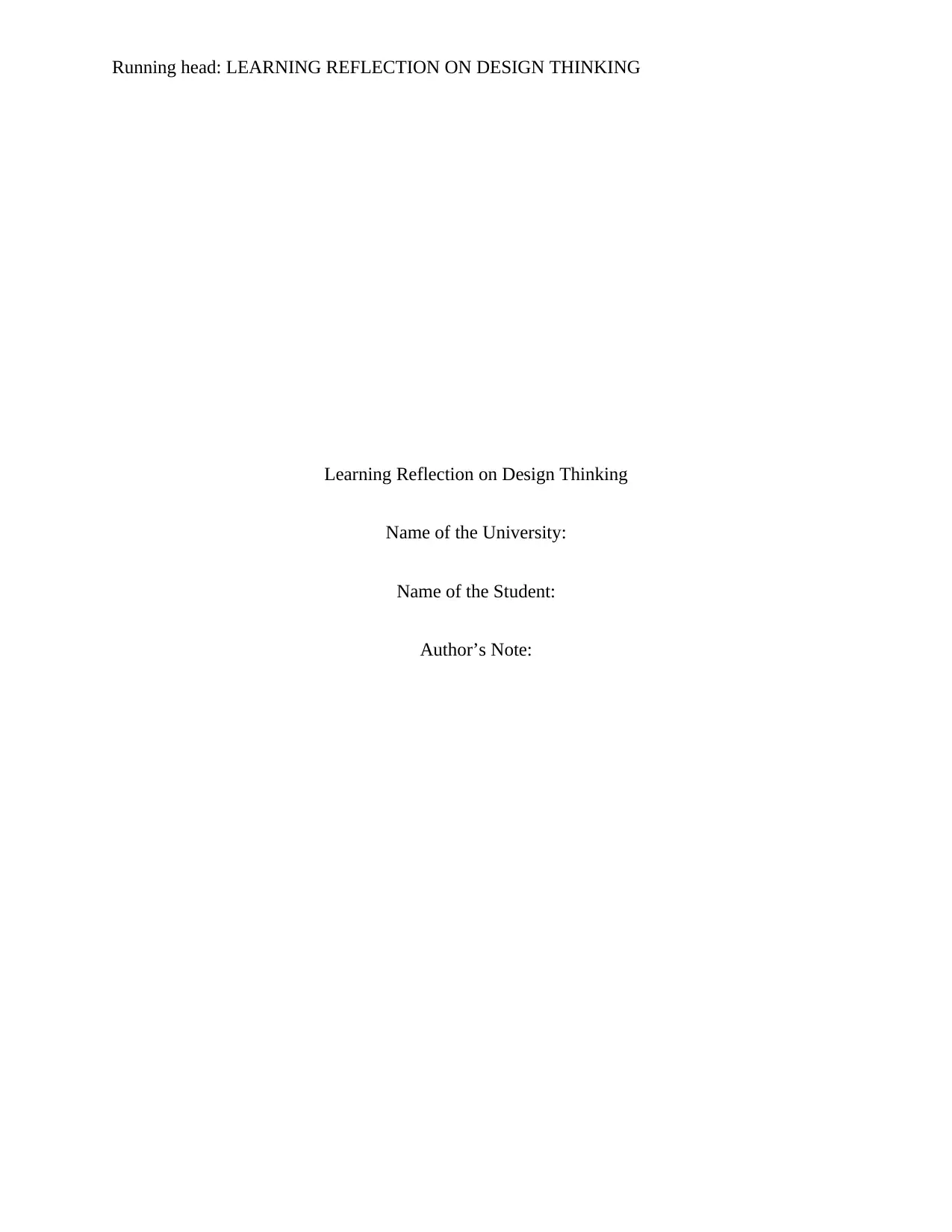
Running head: LEARNING REFLECTION ON DESIGN THINKING
Learning Reflection on Design Thinking
Name of the University:
Name of the Student:
Author’s Note:
Learning Reflection on Design Thinking
Name of the University:
Name of the Student:
Author’s Note:
Paraphrase This Document
Need a fresh take? Get an instant paraphrase of this document with our AI Paraphraser
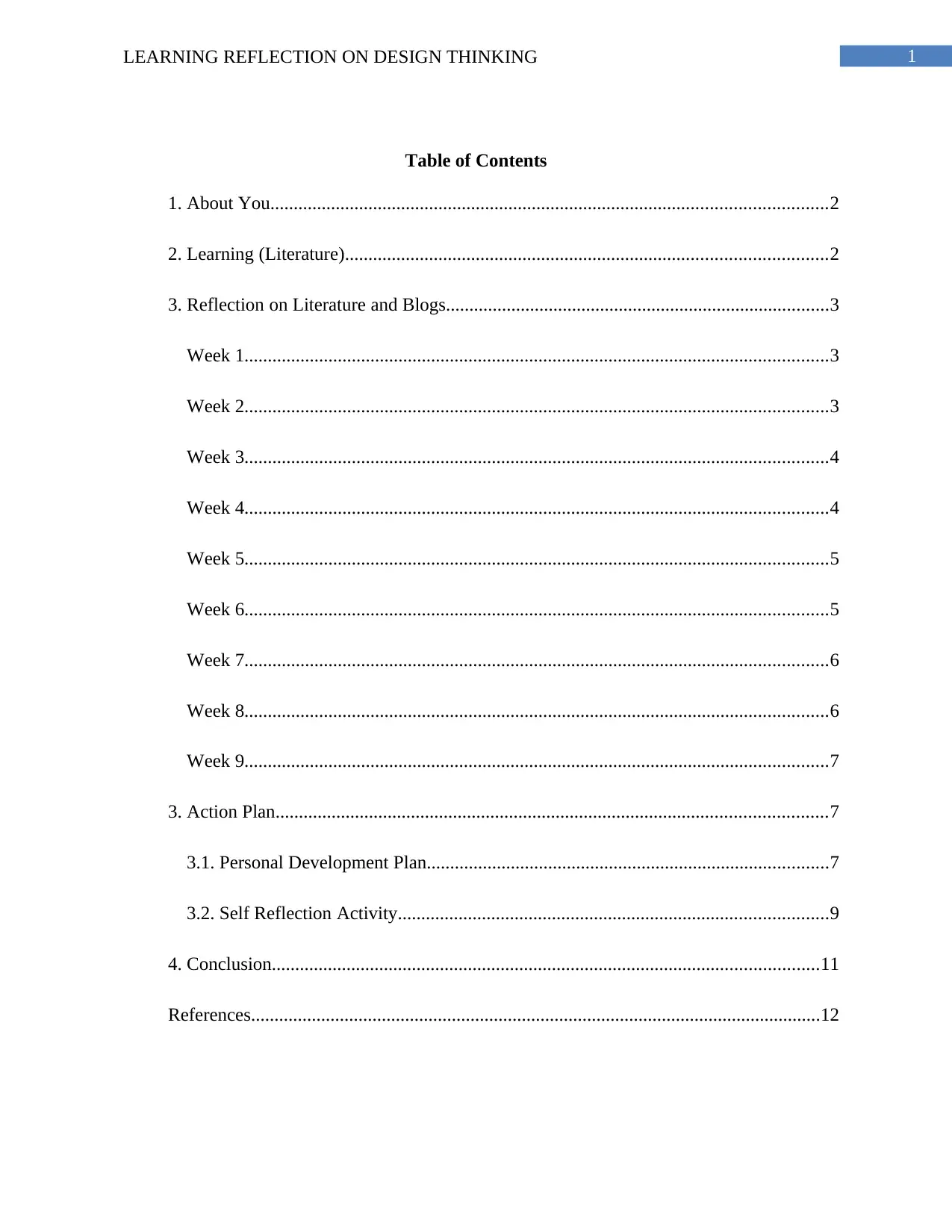
LEARNING REFLECTION ON DESIGN THINKING 1
Table of Contents
1. About You.......................................................................................................................2
2. Learning (Literature).......................................................................................................2
3. Reflection on Literature and Blogs..................................................................................3
Week 1.............................................................................................................................3
Week 2.............................................................................................................................3
Week 3.............................................................................................................................4
Week 4.............................................................................................................................4
Week 5.............................................................................................................................5
Week 6.............................................................................................................................5
Week 7.............................................................................................................................6
Week 8.............................................................................................................................6
Week 9.............................................................................................................................7
3. Action Plan......................................................................................................................7
3.1. Personal Development Plan......................................................................................7
3.2. Self Reflection Activity............................................................................................9
4. Conclusion.....................................................................................................................11
References..........................................................................................................................12
Table of Contents
1. About You.......................................................................................................................2
2. Learning (Literature).......................................................................................................2
3. Reflection on Literature and Blogs..................................................................................3
Week 1.............................................................................................................................3
Week 2.............................................................................................................................3
Week 3.............................................................................................................................4
Week 4.............................................................................................................................4
Week 5.............................................................................................................................5
Week 6.............................................................................................................................5
Week 7.............................................................................................................................6
Week 8.............................................................................................................................6
Week 9.............................................................................................................................7
3. Action Plan......................................................................................................................7
3.1. Personal Development Plan......................................................................................7
3.2. Self Reflection Activity............................................................................................9
4. Conclusion.....................................................................................................................11
References..........................................................................................................................12
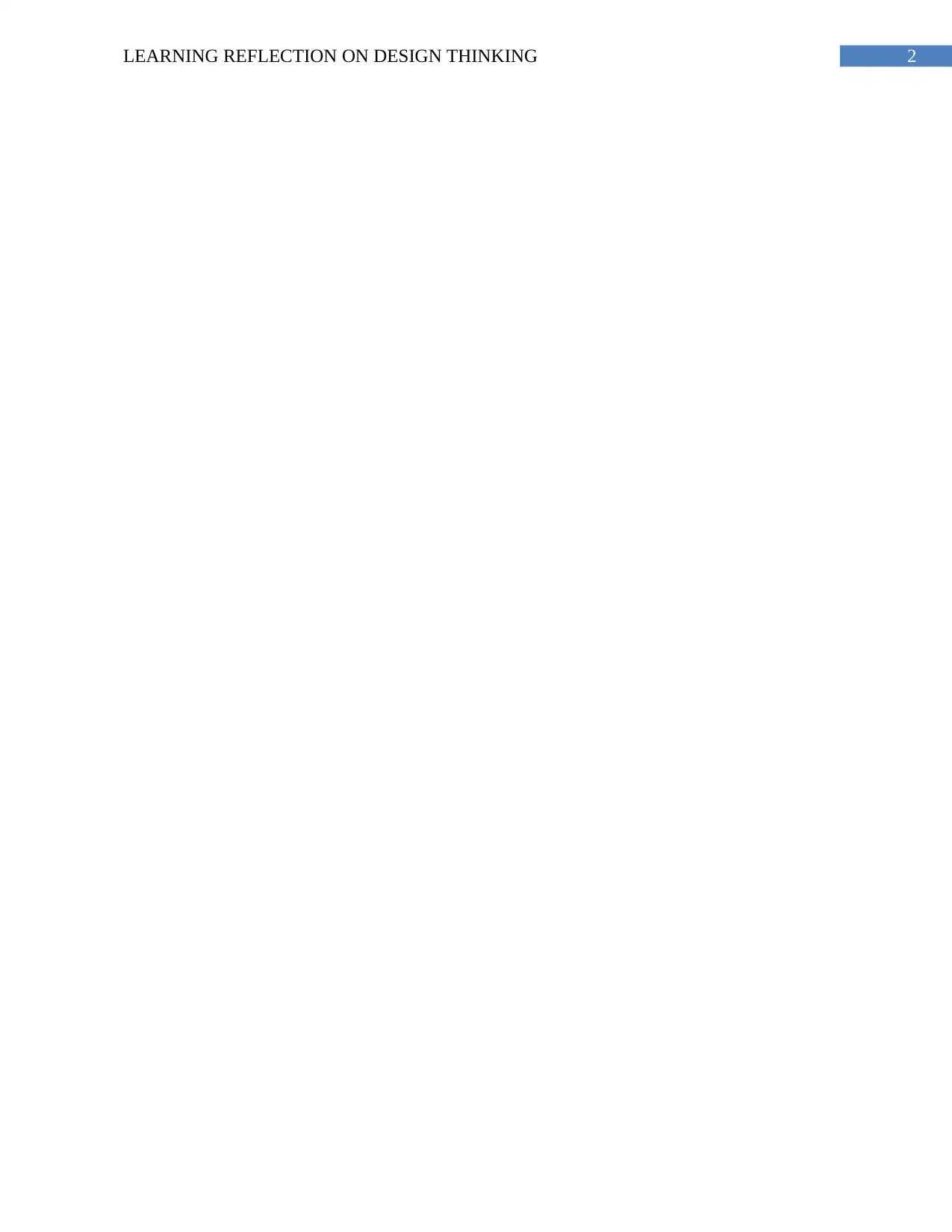
2LEARNING REFLECTION ON DESIGN THINKING
⊘ This is a preview!⊘
Do you want full access?
Subscribe today to unlock all pages.

Trusted by 1+ million students worldwide
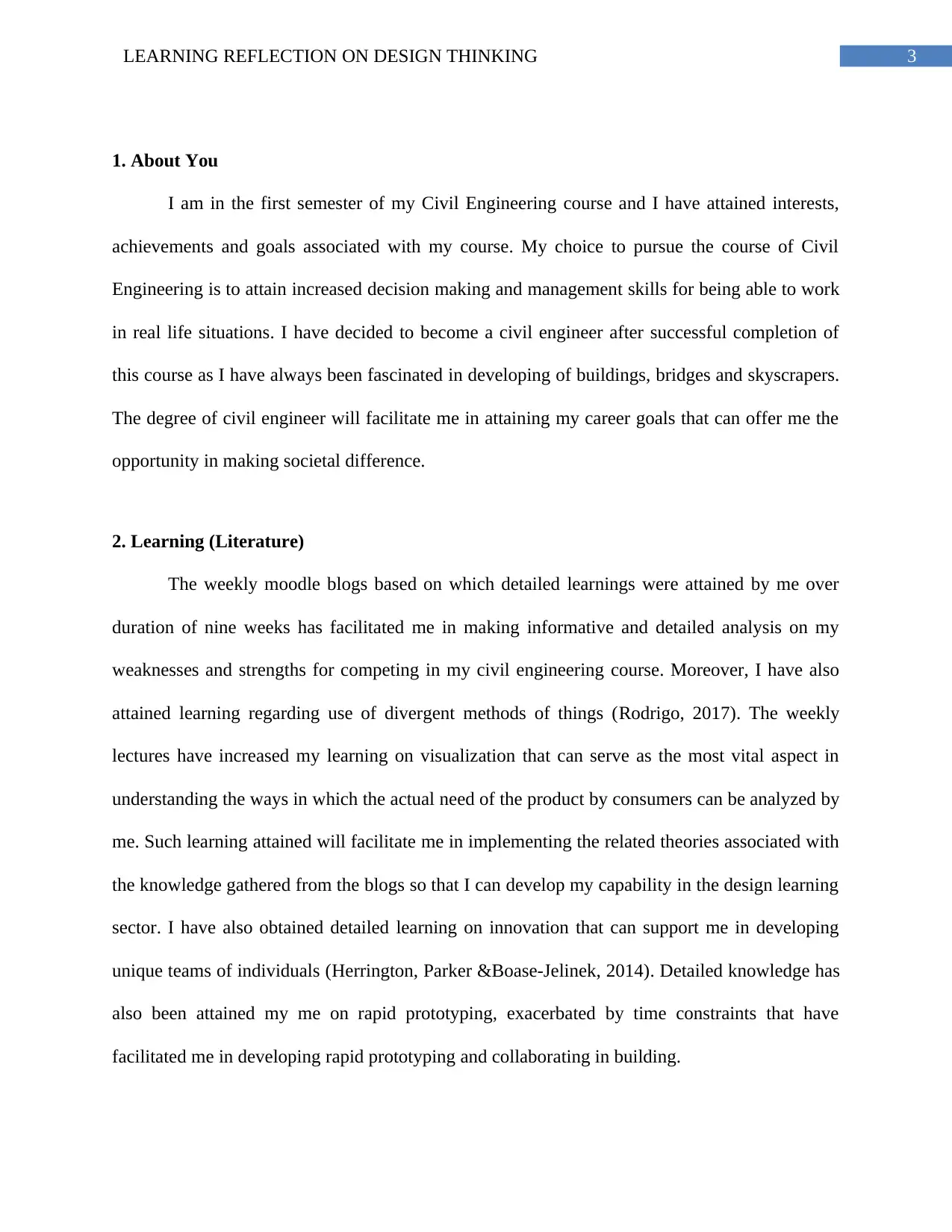
3LEARNING REFLECTION ON DESIGN THINKING
1. About You
I am in the first semester of my Civil Engineering course and I have attained interests,
achievements and goals associated with my course. My choice to pursue the course of Civil
Engineering is to attain increased decision making and management skills for being able to work
in real life situations. I have decided to become a civil engineer after successful completion of
this course as I have always been fascinated in developing of buildings, bridges and skyscrapers.
The degree of civil engineer will facilitate me in attaining my career goals that can offer me the
opportunity in making societal difference.
2. Learning (Literature)
The weekly moodle blogs based on which detailed learnings were attained by me over
duration of nine weeks has facilitated me in making informative and detailed analysis on my
weaknesses and strengths for competing in my civil engineering course. Moreover, I have also
attained learning regarding use of divergent methods of things (Rodrigo, 2017). The weekly
lectures have increased my learning on visualization that can serve as the most vital aspect in
understanding the ways in which the actual need of the product by consumers can be analyzed by
me. Such learning attained will facilitate me in implementing the related theories associated with
the knowledge gathered from the blogs so that I can develop my capability in the design learning
sector. I have also obtained detailed learning on innovation that can support me in developing
unique teams of individuals (Herrington, Parker &Boase-Jelinek, 2014). Detailed knowledge has
also been attained my me on rapid prototyping, exacerbated by time constraints that have
facilitated me in developing rapid prototyping and collaborating in building.
1. About You
I am in the first semester of my Civil Engineering course and I have attained interests,
achievements and goals associated with my course. My choice to pursue the course of Civil
Engineering is to attain increased decision making and management skills for being able to work
in real life situations. I have decided to become a civil engineer after successful completion of
this course as I have always been fascinated in developing of buildings, bridges and skyscrapers.
The degree of civil engineer will facilitate me in attaining my career goals that can offer me the
opportunity in making societal difference.
2. Learning (Literature)
The weekly moodle blogs based on which detailed learnings were attained by me over
duration of nine weeks has facilitated me in making informative and detailed analysis on my
weaknesses and strengths for competing in my civil engineering course. Moreover, I have also
attained learning regarding use of divergent methods of things (Rodrigo, 2017). The weekly
lectures have increased my learning on visualization that can serve as the most vital aspect in
understanding the ways in which the actual need of the product by consumers can be analyzed by
me. Such learning attained will facilitate me in implementing the related theories associated with
the knowledge gathered from the blogs so that I can develop my capability in the design learning
sector. I have also obtained detailed learning on innovation that can support me in developing
unique teams of individuals (Herrington, Parker &Boase-Jelinek, 2014). Detailed knowledge has
also been attained my me on rapid prototyping, exacerbated by time constraints that have
facilitated me in developing rapid prototyping and collaborating in building.
Paraphrase This Document
Need a fresh take? Get an instant paraphrase of this document with our AI Paraphraser
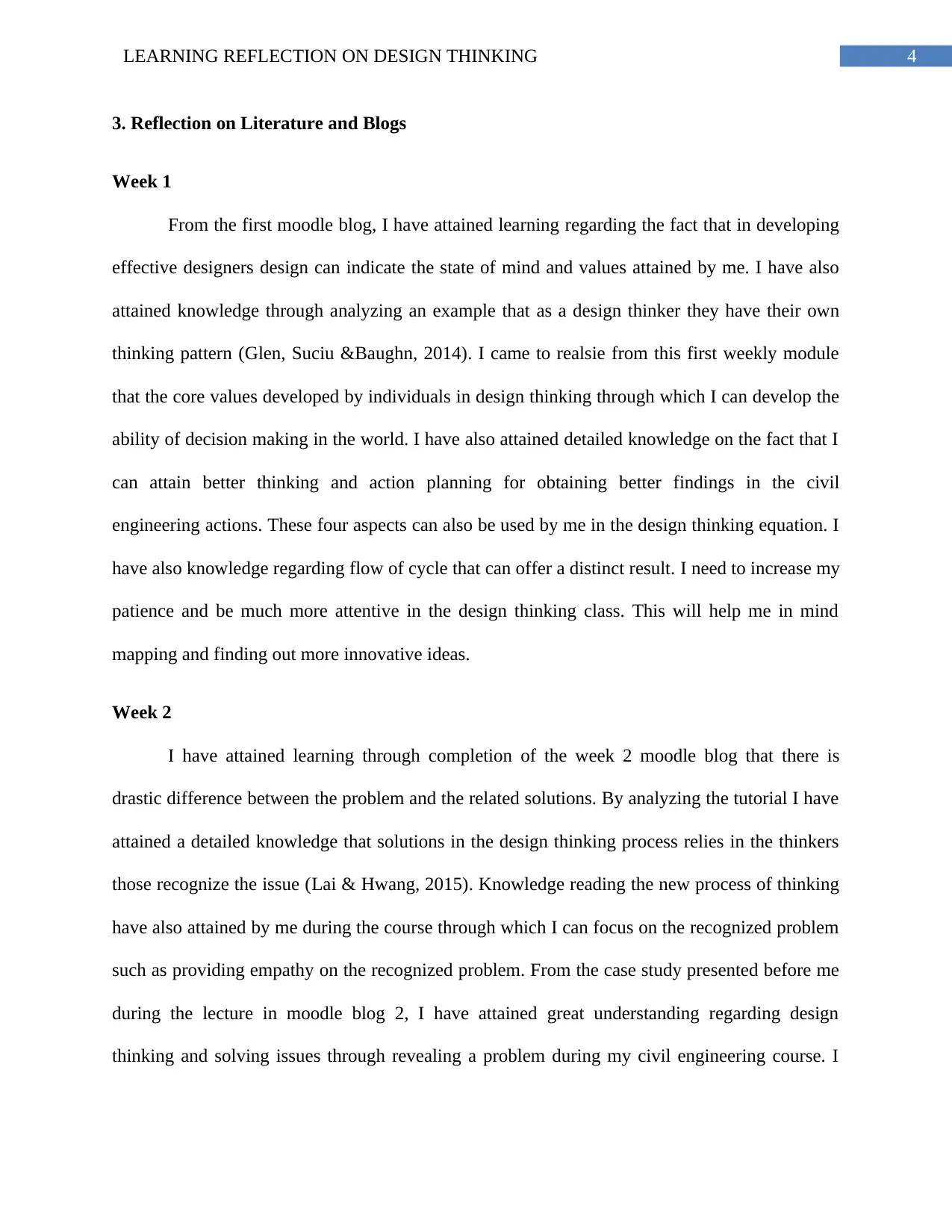
4LEARNING REFLECTION ON DESIGN THINKING
3. Reflection on Literature and Blogs
Week 1
From the first moodle blog, I have attained learning regarding the fact that in developing
effective designers design can indicate the state of mind and values attained by me. I have also
attained knowledge through analyzing an example that as a design thinker they have their own
thinking pattern (Glen, Suciu &Baughn, 2014). I came to realsie from this first weekly module
that the core values developed by individuals in design thinking through which I can develop the
ability of decision making in the world. I have also attained detailed knowledge on the fact that I
can attain better thinking and action planning for obtaining better findings in the civil
engineering actions. These four aspects can also be used by me in the design thinking equation. I
have also knowledge regarding flow of cycle that can offer a distinct result. I need to increase my
patience and be much more attentive in the design thinking class. This will help me in mind
mapping and finding out more innovative ideas.
Week 2
I have attained learning through completion of the week 2 moodle blog that there is
drastic difference between the problem and the related solutions. By analyzing the tutorial I have
attained a detailed knowledge that solutions in the design thinking process relies in the thinkers
those recognize the issue (Lai & Hwang, 2015). Knowledge reading the new process of thinking
have also attained by me during the course through which I can focus on the recognized problem
such as providing empathy on the recognized problem. From the case study presented before me
during the lecture in moodle blog 2, I have attained great understanding regarding design
thinking and solving issues through revealing a problem during my civil engineering course. I
3. Reflection on Literature and Blogs
Week 1
From the first moodle blog, I have attained learning regarding the fact that in developing
effective designers design can indicate the state of mind and values attained by me. I have also
attained knowledge through analyzing an example that as a design thinker they have their own
thinking pattern (Glen, Suciu &Baughn, 2014). I came to realsie from this first weekly module
that the core values developed by individuals in design thinking through which I can develop the
ability of decision making in the world. I have also attained detailed knowledge on the fact that I
can attain better thinking and action planning for obtaining better findings in the civil
engineering actions. These four aspects can also be used by me in the design thinking equation. I
have also knowledge regarding flow of cycle that can offer a distinct result. I need to increase my
patience and be much more attentive in the design thinking class. This will help me in mind
mapping and finding out more innovative ideas.
Week 2
I have attained learning through completion of the week 2 moodle blog that there is
drastic difference between the problem and the related solutions. By analyzing the tutorial I have
attained a detailed knowledge that solutions in the design thinking process relies in the thinkers
those recognize the issue (Lai & Hwang, 2015). Knowledge reading the new process of thinking
have also attained by me during the course through which I can focus on the recognized problem
such as providing empathy on the recognized problem. From the case study presented before me
during the lecture in moodle blog 2, I have attained great understanding regarding design
thinking and solving issues through revealing a problem during my civil engineering course. I
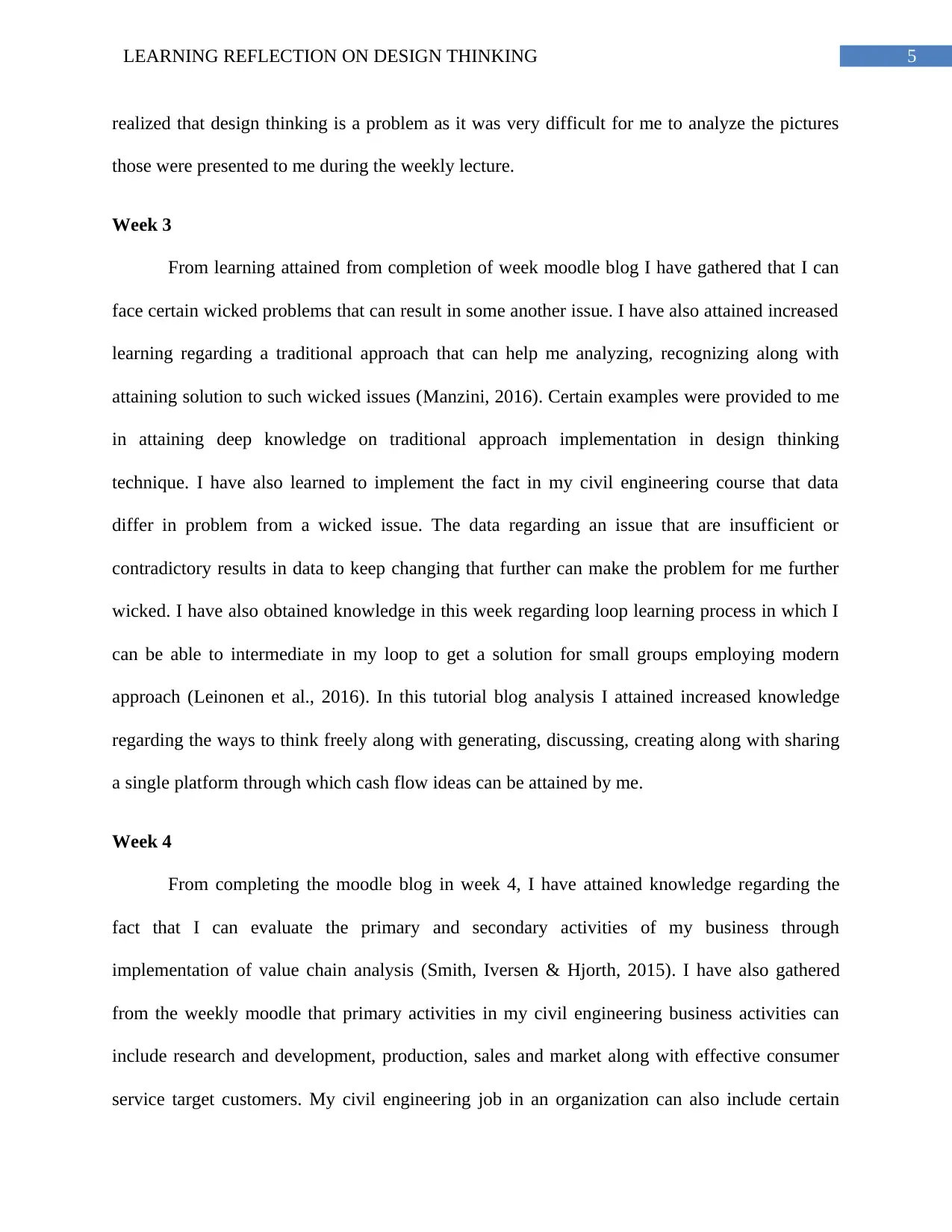
5LEARNING REFLECTION ON DESIGN THINKING
realized that design thinking is a problem as it was very difficult for me to analyze the pictures
those were presented to me during the weekly lecture.
Week 3
From learning attained from completion of week moodle blog I have gathered that I can
face certain wicked problems that can result in some another issue. I have also attained increased
learning regarding a traditional approach that can help me analyzing, recognizing along with
attaining solution to such wicked issues (Manzini, 2016). Certain examples were provided to me
in attaining deep knowledge on traditional approach implementation in design thinking
technique. I have also learned to implement the fact in my civil engineering course that data
differ in problem from a wicked issue. The data regarding an issue that are insufficient or
contradictory results in data to keep changing that further can make the problem for me further
wicked. I have also obtained knowledge in this week regarding loop learning process in which I
can be able to intermediate in my loop to get a solution for small groups employing modern
approach (Leinonen et al., 2016). In this tutorial blog analysis I attained increased knowledge
regarding the ways to think freely along with generating, discussing, creating along with sharing
a single platform through which cash flow ideas can be attained by me.
Week 4
From completing the moodle blog in week 4, I have attained knowledge regarding the
fact that I can evaluate the primary and secondary activities of my business through
implementation of value chain analysis (Smith, Iversen & Hjorth, 2015). I have also gathered
from the weekly moodle that primary activities in my civil engineering business activities can
include research and development, production, sales and market along with effective consumer
service target customers. My civil engineering job in an organization can also include certain
realized that design thinking is a problem as it was very difficult for me to analyze the pictures
those were presented to me during the weekly lecture.
Week 3
From learning attained from completion of week moodle blog I have gathered that I can
face certain wicked problems that can result in some another issue. I have also attained increased
learning regarding a traditional approach that can help me analyzing, recognizing along with
attaining solution to such wicked issues (Manzini, 2016). Certain examples were provided to me
in attaining deep knowledge on traditional approach implementation in design thinking
technique. I have also learned to implement the fact in my civil engineering course that data
differ in problem from a wicked issue. The data regarding an issue that are insufficient or
contradictory results in data to keep changing that further can make the problem for me further
wicked. I have also obtained knowledge in this week regarding loop learning process in which I
can be able to intermediate in my loop to get a solution for small groups employing modern
approach (Leinonen et al., 2016). In this tutorial blog analysis I attained increased knowledge
regarding the ways to think freely along with generating, discussing, creating along with sharing
a single platform through which cash flow ideas can be attained by me.
Week 4
From completing the moodle blog in week 4, I have attained knowledge regarding the
fact that I can evaluate the primary and secondary activities of my business through
implementation of value chain analysis (Smith, Iversen & Hjorth, 2015). I have also gathered
from the weekly moodle that primary activities in my civil engineering business activities can
include research and development, production, sales and market along with effective consumer
service target customers. My civil engineering job in an organization can also include certain
⊘ This is a preview!⊘
Do you want full access?
Subscribe today to unlock all pages.

Trusted by 1+ million students worldwide
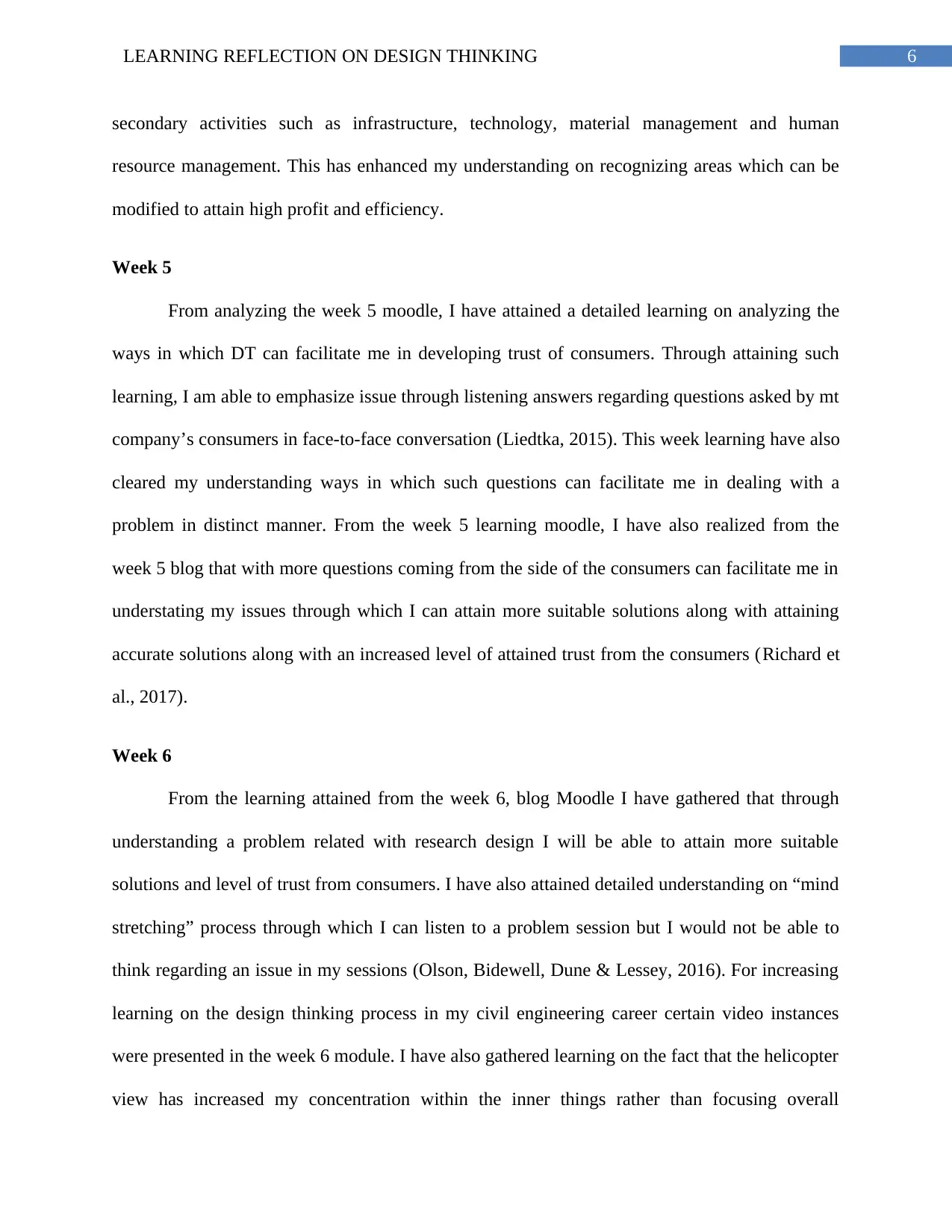
6LEARNING REFLECTION ON DESIGN THINKING
secondary activities such as infrastructure, technology, material management and human
resource management. This has enhanced my understanding on recognizing areas which can be
modified to attain high profit and efficiency.
Week 5
From analyzing the week 5 moodle, I have attained a detailed learning on analyzing the
ways in which DT can facilitate me in developing trust of consumers. Through attaining such
learning, I am able to emphasize issue through listening answers regarding questions asked by mt
company’s consumers in face-to-face conversation (Liedtka, 2015). This week learning have also
cleared my understanding ways in which such questions can facilitate me in dealing with a
problem in distinct manner. From the week 5 learning moodle, I have also realized from the
week 5 blog that with more questions coming from the side of the consumers can facilitate me in
understating my issues through which I can attain more suitable solutions along with attaining
accurate solutions along with an increased level of attained trust from the consumers (Richard et
al., 2017).
Week 6
From the learning attained from the week 6, blog Moodle I have gathered that through
understanding a problem related with research design I will be able to attain more suitable
solutions and level of trust from consumers. I have also attained detailed understanding on “mind
stretching” process through which I can listen to a problem session but I would not be able to
think regarding an issue in my sessions (Olson, Bidewell, Dune & Lessey, 2016). For increasing
learning on the design thinking process in my civil engineering career certain video instances
were presented in the week 6 module. I have also gathered learning on the fact that the helicopter
view has increased my concentration within the inner things rather than focusing overall
secondary activities such as infrastructure, technology, material management and human
resource management. This has enhanced my understanding on recognizing areas which can be
modified to attain high profit and efficiency.
Week 5
From analyzing the week 5 moodle, I have attained a detailed learning on analyzing the
ways in which DT can facilitate me in developing trust of consumers. Through attaining such
learning, I am able to emphasize issue through listening answers regarding questions asked by mt
company’s consumers in face-to-face conversation (Liedtka, 2015). This week learning have also
cleared my understanding ways in which such questions can facilitate me in dealing with a
problem in distinct manner. From the week 5 learning moodle, I have also realized from the
week 5 blog that with more questions coming from the side of the consumers can facilitate me in
understating my issues through which I can attain more suitable solutions along with attaining
accurate solutions along with an increased level of attained trust from the consumers (Richard et
al., 2017).
Week 6
From the learning attained from the week 6, blog Moodle I have gathered that through
understanding a problem related with research design I will be able to attain more suitable
solutions and level of trust from consumers. I have also attained detailed understanding on “mind
stretching” process through which I can listen to a problem session but I would not be able to
think regarding an issue in my sessions (Olson, Bidewell, Dune & Lessey, 2016). For increasing
learning on the design thinking process in my civil engineering career certain video instances
were presented in the week 6 module. I have also gathered learning on the fact that the helicopter
view has increased my concentration within the inner things rather than focusing overall
Paraphrase This Document
Need a fresh take? Get an instant paraphrase of this document with our AI Paraphraser
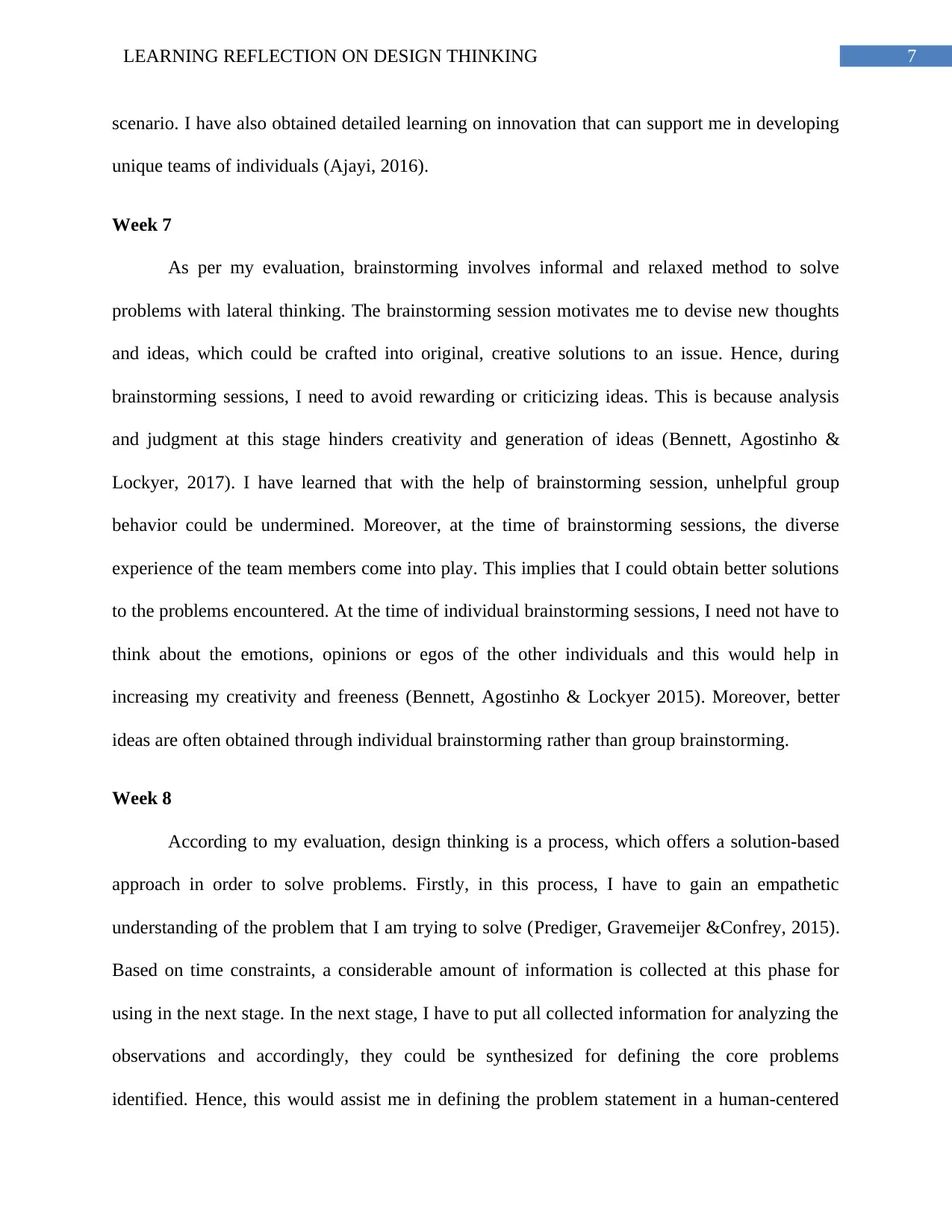
7LEARNING REFLECTION ON DESIGN THINKING
scenario. I have also obtained detailed learning on innovation that can support me in developing
unique teams of individuals (Ajayi, 2016).
Week 7
As per my evaluation, brainstorming involves informal and relaxed method to solve
problems with lateral thinking. The brainstorming session motivates me to devise new thoughts
and ideas, which could be crafted into original, creative solutions to an issue. Hence, during
brainstorming sessions, I need to avoid rewarding or criticizing ideas. This is because analysis
and judgment at this stage hinders creativity and generation of ideas (Bennett, Agostinho &
Lockyer, 2017). I have learned that with the help of brainstorming session, unhelpful group
behavior could be undermined. Moreover, at the time of brainstorming sessions, the diverse
experience of the team members come into play. This implies that I could obtain better solutions
to the problems encountered. At the time of individual brainstorming sessions, I need not have to
think about the emotions, opinions or egos of the other individuals and this would help in
increasing my creativity and freeness (Bennett, Agostinho & Lockyer 2015). Moreover, better
ideas are often obtained through individual brainstorming rather than group brainstorming.
Week 8
According to my evaluation, design thinking is a process, which offers a solution-based
approach in order to solve problems. Firstly, in this process, I have to gain an empathetic
understanding of the problem that I am trying to solve (Prediger, Gravemeijer &Confrey, 2015).
Based on time constraints, a considerable amount of information is collected at this phase for
using in the next stage. In the next stage, I have to put all collected information for analyzing the
observations and accordingly, they could be synthesized for defining the core problems
identified. Hence, this would assist me in defining the problem statement in a human-centered
scenario. I have also obtained detailed learning on innovation that can support me in developing
unique teams of individuals (Ajayi, 2016).
Week 7
As per my evaluation, brainstorming involves informal and relaxed method to solve
problems with lateral thinking. The brainstorming session motivates me to devise new thoughts
and ideas, which could be crafted into original, creative solutions to an issue. Hence, during
brainstorming sessions, I need to avoid rewarding or criticizing ideas. This is because analysis
and judgment at this stage hinders creativity and generation of ideas (Bennett, Agostinho &
Lockyer, 2017). I have learned that with the help of brainstorming session, unhelpful group
behavior could be undermined. Moreover, at the time of brainstorming sessions, the diverse
experience of the team members come into play. This implies that I could obtain better solutions
to the problems encountered. At the time of individual brainstorming sessions, I need not have to
think about the emotions, opinions or egos of the other individuals and this would help in
increasing my creativity and freeness (Bennett, Agostinho & Lockyer 2015). Moreover, better
ideas are often obtained through individual brainstorming rather than group brainstorming.
Week 8
According to my evaluation, design thinking is a process, which offers a solution-based
approach in order to solve problems. Firstly, in this process, I have to gain an empathetic
understanding of the problem that I am trying to solve (Prediger, Gravemeijer &Confrey, 2015).
Based on time constraints, a considerable amount of information is collected at this phase for
using in the next stage. In the next stage, I have to put all collected information for analyzing the
observations and accordingly, they could be synthesized for defining the core problems
identified. Hence, this would assist me in defining the problem statement in a human-centered
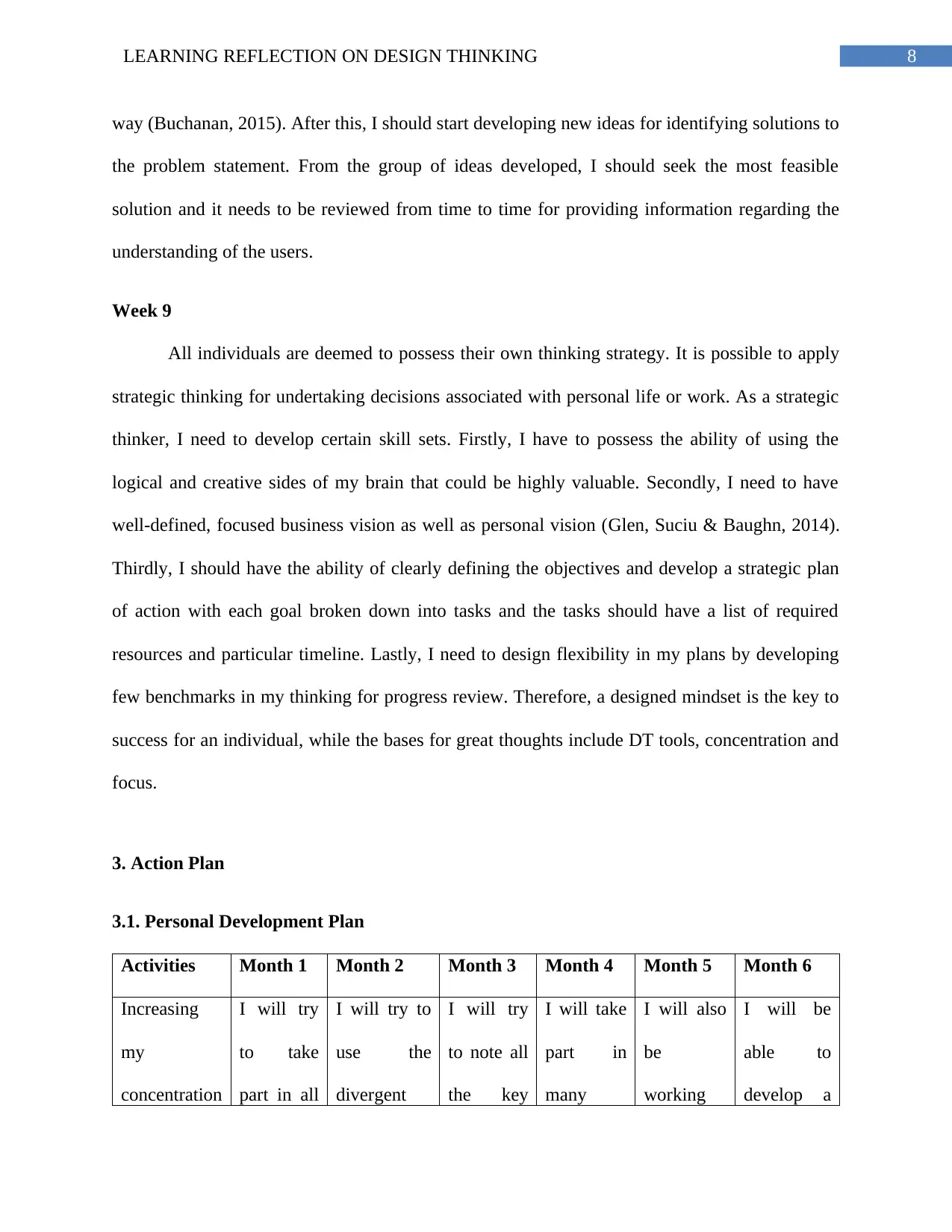
8LEARNING REFLECTION ON DESIGN THINKING
way (Buchanan, 2015). After this, I should start developing new ideas for identifying solutions to
the problem statement. From the group of ideas developed, I should seek the most feasible
solution and it needs to be reviewed from time to time for providing information regarding the
understanding of the users.
Week 9
All individuals are deemed to possess their own thinking strategy. It is possible to apply
strategic thinking for undertaking decisions associated with personal life or work. As a strategic
thinker, I need to develop certain skill sets. Firstly, I have to possess the ability of using the
logical and creative sides of my brain that could be highly valuable. Secondly, I need to have
well-defined, focused business vision as well as personal vision (Glen, Suciu & Baughn, 2014).
Thirdly, I should have the ability of clearly defining the objectives and develop a strategic plan
of action with each goal broken down into tasks and the tasks should have a list of required
resources and particular timeline. Lastly, I need to design flexibility in my plans by developing
few benchmarks in my thinking for progress review. Therefore, a designed mindset is the key to
success for an individual, while the bases for great thoughts include DT tools, concentration and
focus.
3. Action Plan
3.1. Personal Development Plan
Activities Month 1 Month 2 Month 3 Month 4 Month 5 Month 6
Increasing
my
concentration
I will try
to take
part in all
I will try to
use the
divergent
I will try
to note all
the key
I will take
part in
many
I will also
be
working
I will be
able to
develop a
way (Buchanan, 2015). After this, I should start developing new ideas for identifying solutions to
the problem statement. From the group of ideas developed, I should seek the most feasible
solution and it needs to be reviewed from time to time for providing information regarding the
understanding of the users.
Week 9
All individuals are deemed to possess their own thinking strategy. It is possible to apply
strategic thinking for undertaking decisions associated with personal life or work. As a strategic
thinker, I need to develop certain skill sets. Firstly, I have to possess the ability of using the
logical and creative sides of my brain that could be highly valuable. Secondly, I need to have
well-defined, focused business vision as well as personal vision (Glen, Suciu & Baughn, 2014).
Thirdly, I should have the ability of clearly defining the objectives and develop a strategic plan
of action with each goal broken down into tasks and the tasks should have a list of required
resources and particular timeline. Lastly, I need to design flexibility in my plans by developing
few benchmarks in my thinking for progress review. Therefore, a designed mindset is the key to
success for an individual, while the bases for great thoughts include DT tools, concentration and
focus.
3. Action Plan
3.1. Personal Development Plan
Activities Month 1 Month 2 Month 3 Month 4 Month 5 Month 6
Increasing
my
concentration
I will try
to take
part in all
I will try to
use the
divergent
I will try
to note all
the key
I will take
part in
many
I will also
be
working
I will be
able to
develop a
⊘ This is a preview!⊘
Do you want full access?
Subscribe today to unlock all pages.

Trusted by 1+ million students worldwide
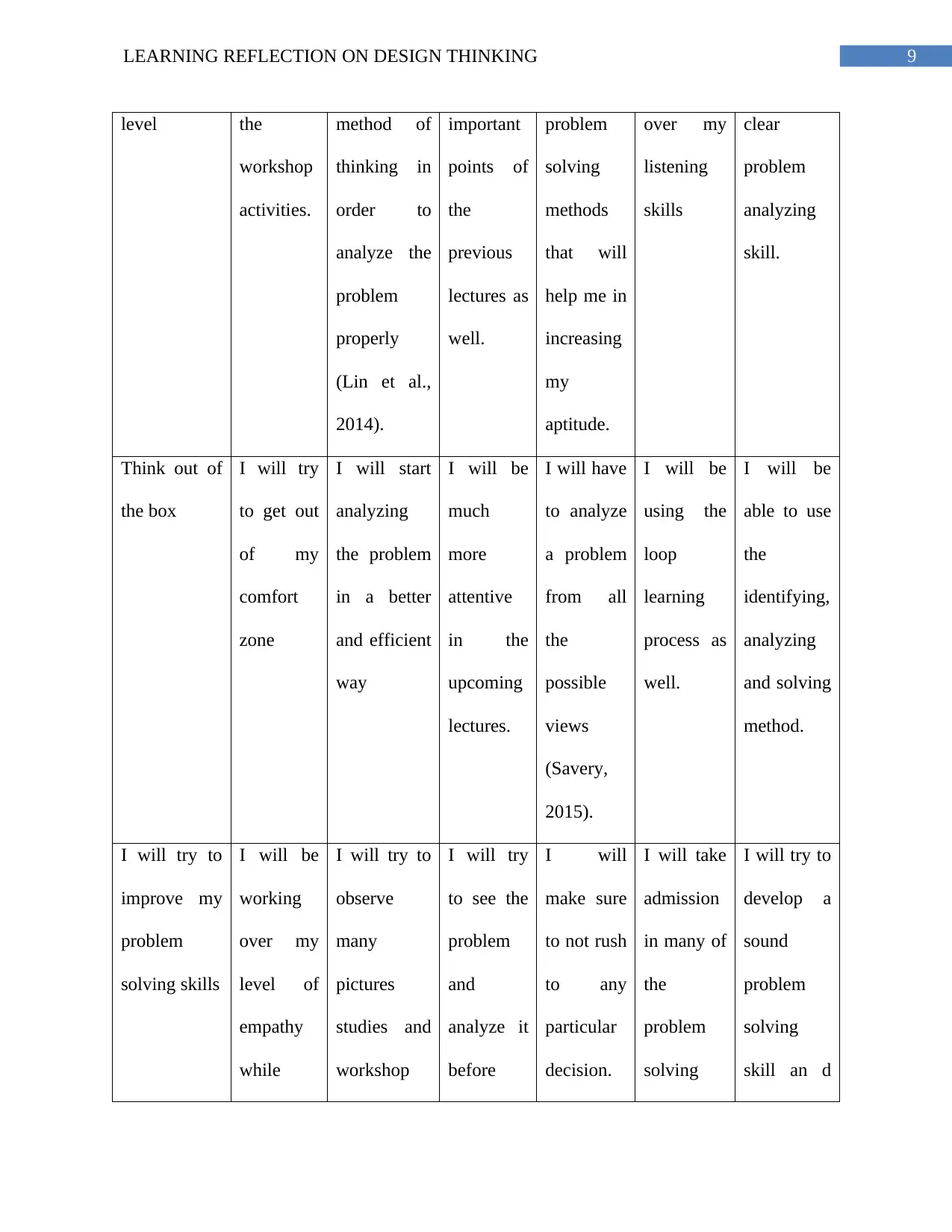
9LEARNING REFLECTION ON DESIGN THINKING
level the
workshop
activities.
method of
thinking in
order to
analyze the
problem
properly
(Lin et al.,
2014).
important
points of
the
previous
lectures as
well.
problem
solving
methods
that will
help me in
increasing
my
aptitude.
over my
listening
skills
clear
problem
analyzing
skill.
Think out of
the box
I will try
to get out
of my
comfort
zone
I will start
analyzing
the problem
in a better
and efficient
way
I will be
much
more
attentive
in the
upcoming
lectures.
I will have
to analyze
a problem
from all
the
possible
views
(Savery,
2015).
I will be
using the
loop
learning
process as
well.
I will be
able to use
the
identifying,
analyzing
and solving
method.
I will try to
improve my
problem
solving skills
I will be
working
over my
level of
empathy
while
I will try to
observe
many
pictures
studies and
workshop
I will try
to see the
problem
and
analyze it
before
I will
make sure
to not rush
to any
particular
decision.
I will take
admission
in many of
the
problem
solving
I will try to
develop a
sound
problem
solving
skill an d
level the
workshop
activities.
method of
thinking in
order to
analyze the
problem
properly
(Lin et al.,
2014).
important
points of
the
previous
lectures as
well.
problem
solving
methods
that will
help me in
increasing
my
aptitude.
over my
listening
skills
clear
problem
analyzing
skill.
Think out of
the box
I will try
to get out
of my
comfort
zone
I will start
analyzing
the problem
in a better
and efficient
way
I will be
much
more
attentive
in the
upcoming
lectures.
I will have
to analyze
a problem
from all
the
possible
views
(Savery,
2015).
I will be
using the
loop
learning
process as
well.
I will be
able to use
the
identifying,
analyzing
and solving
method.
I will try to
improve my
problem
solving skills
I will be
working
over my
level of
empathy
while
I will try to
observe
many
pictures
studies and
workshop
I will try
to see the
problem
and
analyze it
before
I will
make sure
to not rush
to any
particular
decision.
I will take
admission
in many of
the
problem
solving
I will try to
develop a
sound
problem
solving
skill an d
Paraphrase This Document
Need a fresh take? Get an instant paraphrase of this document with our AI Paraphraser
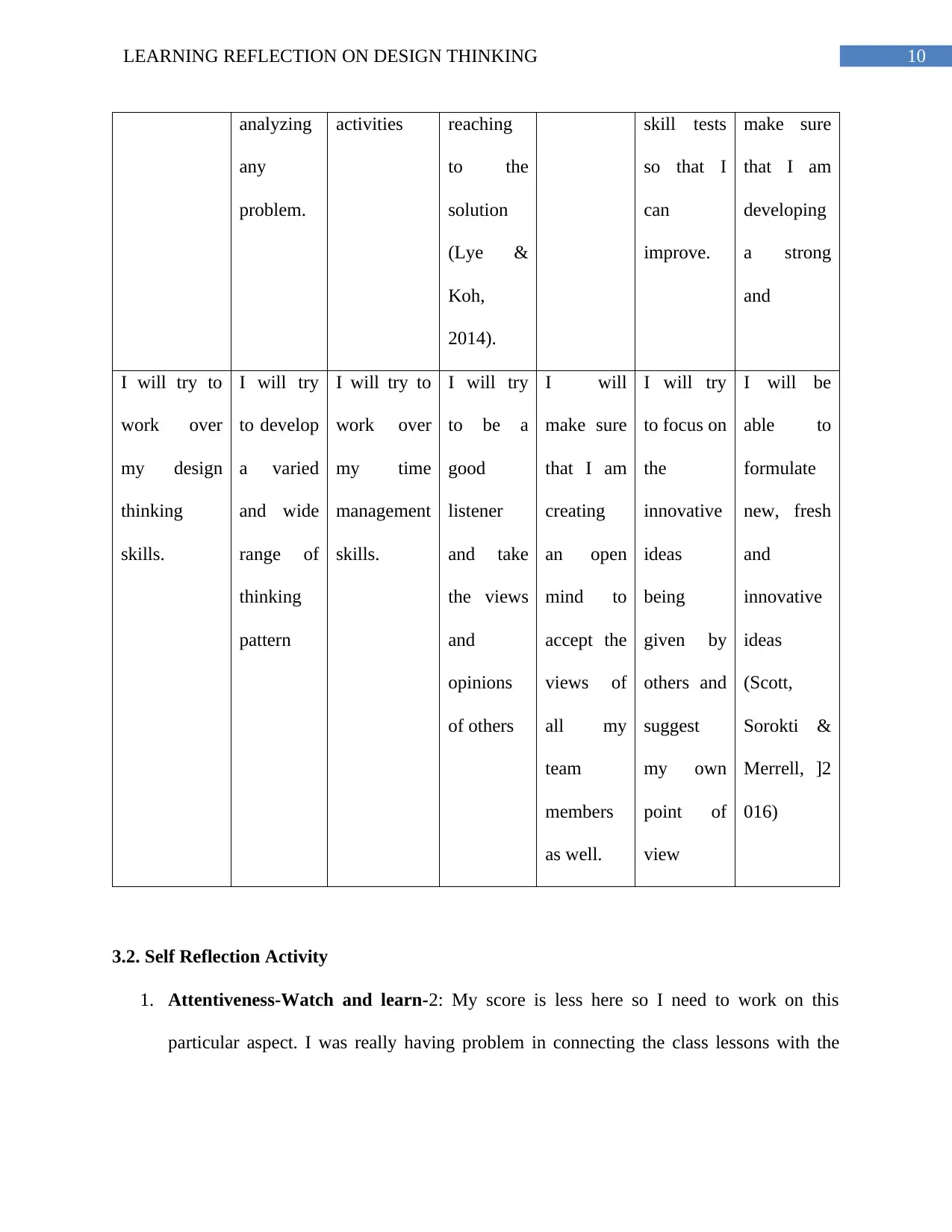
10LEARNING REFLECTION ON DESIGN THINKING
analyzing
any
problem.
activities reaching
to the
solution
(Lye &
Koh,
2014).
skill tests
so that I
can
improve.
make sure
that I am
developing
a strong
and
I will try to
work over
my design
thinking
skills.
I will try
to develop
a varied
and wide
range of
thinking
pattern
I will try to
work over
my time
management
skills.
I will try
to be a
good
listener
and take
the views
and
opinions
of others
I will
make sure
that I am
creating
an open
mind to
accept the
views of
all my
team
members
as well.
I will try
to focus on
the
innovative
ideas
being
given by
others and
suggest
my own
point of
view
I will be
able to
formulate
new, fresh
and
innovative
ideas
(Scott,
Sorokti &
Merrell, ]2
016)
3.2. Self Reflection Activity
1. Attentiveness-Watch and learn-2: My score is less here so I need to work on this
particular aspect. I was really having problem in connecting the class lessons with the
analyzing
any
problem.
activities reaching
to the
solution
(Lye &
Koh,
2014).
skill tests
so that I
can
improve.
make sure
that I am
developing
a strong
and
I will try to
work over
my design
thinking
skills.
I will try
to develop
a varied
and wide
range of
thinking
pattern
I will try to
work over
my time
management
skills.
I will try
to be a
good
listener
and take
the views
and
opinions
of others
I will
make sure
that I am
creating
an open
mind to
accept the
views of
all my
team
members
as well.
I will try
to focus on
the
innovative
ideas
being
given by
others and
suggest
my own
point of
view
I will be
able to
formulate
new, fresh
and
innovative
ideas
(Scott,
Sorokti &
Merrell, ]2
016)
3.2. Self Reflection Activity
1. Attentiveness-Watch and learn-2: My score is less here so I need to work on this
particular aspect. I was really having problem in connecting the class lessons with the
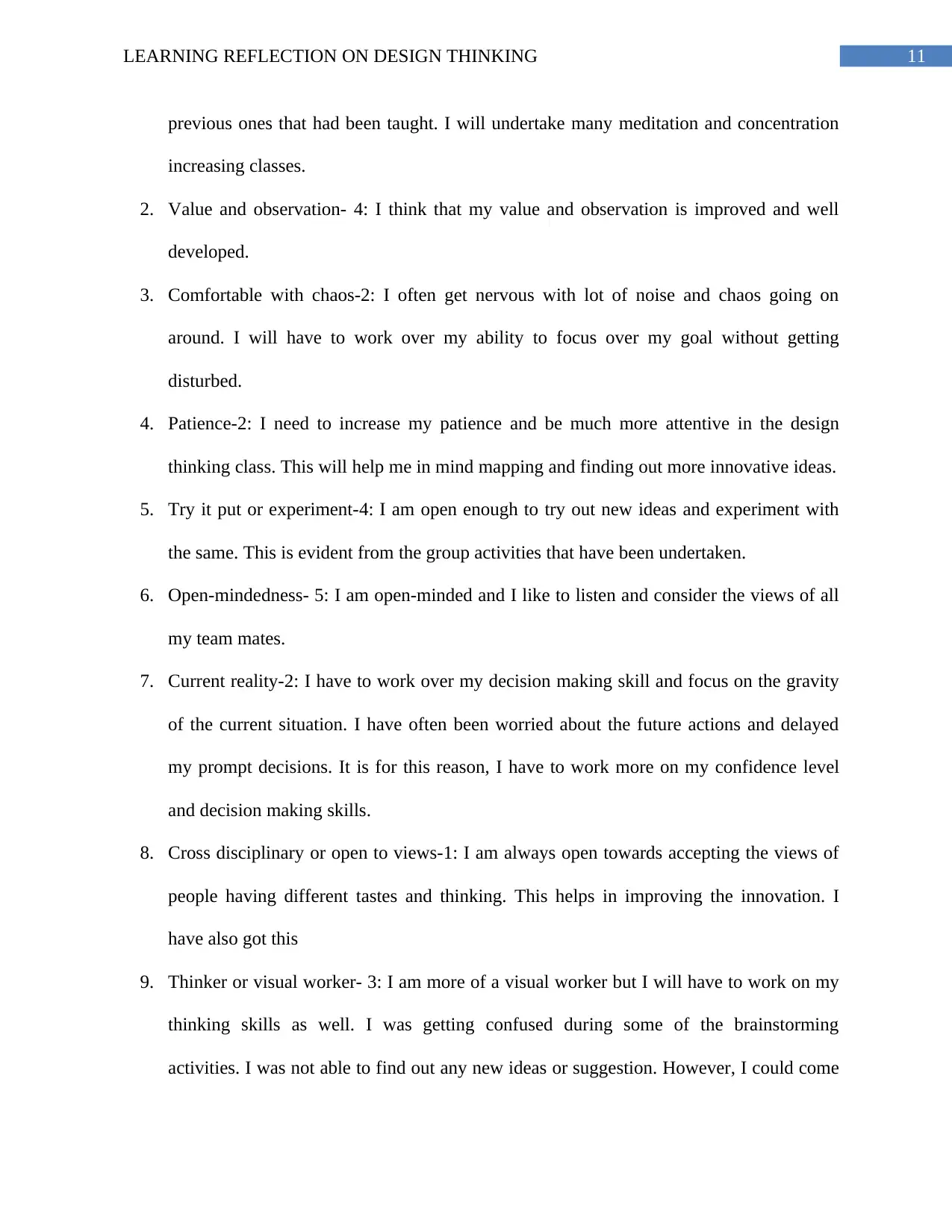
11LEARNING REFLECTION ON DESIGN THINKING
previous ones that had been taught. I will undertake many meditation and concentration
increasing classes.
2. Value and observation- 4: I think that my value and observation is improved and well
developed.
3. Comfortable with chaos-2: I often get nervous with lot of noise and chaos going on
around. I will have to work over my ability to focus over my goal without getting
disturbed.
4. Patience-2: I need to increase my patience and be much more attentive in the design
thinking class. This will help me in mind mapping and finding out more innovative ideas.
5. Try it put or experiment-4: I am open enough to try out new ideas and experiment with
the same. This is evident from the group activities that have been undertaken.
6. Open-mindedness- 5: I am open-minded and I like to listen and consider the views of all
my team mates.
7. Current reality-2: I have to work over my decision making skill and focus on the gravity
of the current situation. I have often been worried about the future actions and delayed
my prompt decisions. It is for this reason, I have to work more on my confidence level
and decision making skills.
8. Cross disciplinary or open to views-1: I am always open towards accepting the views of
people having different tastes and thinking. This helps in improving the innovation. I
have also got this
9. Thinker or visual worker- 3: I am more of a visual worker but I will have to work on my
thinking skills as well. I was getting confused during some of the brainstorming
activities. I was not able to find out any new ideas or suggestion. However, I could come
previous ones that had been taught. I will undertake many meditation and concentration
increasing classes.
2. Value and observation- 4: I think that my value and observation is improved and well
developed.
3. Comfortable with chaos-2: I often get nervous with lot of noise and chaos going on
around. I will have to work over my ability to focus over my goal without getting
disturbed.
4. Patience-2: I need to increase my patience and be much more attentive in the design
thinking class. This will help me in mind mapping and finding out more innovative ideas.
5. Try it put or experiment-4: I am open enough to try out new ideas and experiment with
the same. This is evident from the group activities that have been undertaken.
6. Open-mindedness- 5: I am open-minded and I like to listen and consider the views of all
my team mates.
7. Current reality-2: I have to work over my decision making skill and focus on the gravity
of the current situation. I have often been worried about the future actions and delayed
my prompt decisions. It is for this reason, I have to work more on my confidence level
and decision making skills.
8. Cross disciplinary or open to views-1: I am always open towards accepting the views of
people having different tastes and thinking. This helps in improving the innovation. I
have also got this
9. Thinker or visual worker- 3: I am more of a visual worker but I will have to work on my
thinking skills as well. I was getting confused during some of the brainstorming
activities. I was not able to find out any new ideas or suggestion. However, I could come
⊘ This is a preview!⊘
Do you want full access?
Subscribe today to unlock all pages.

Trusted by 1+ million students worldwide
1 out of 16
Related Documents
Your All-in-One AI-Powered Toolkit for Academic Success.
+13062052269
info@desklib.com
Available 24*7 on WhatsApp / Email
![[object Object]](/_next/static/media/star-bottom.7253800d.svg)
Unlock your academic potential
Copyright © 2020–2025 A2Z Services. All Rights Reserved. Developed and managed by ZUCOL.





